Learn Sādhana
Unlock the Secrets to a Better Life with SRISTI’s Exclusive Training Program
Guru Agastya Gāyatrī Sādhana

GURU-AGASTIYA-GAYATRI-SADHANA, which is based on the principles of ancient yogic science, is a unique and powerful method developed by Agastiya Kulapathi Dr Sri Shakti Sumanan with the grace of the Maha Guru. Practicing this method will give rapid progress in one’s spiritual endeavors leading to mind purification and self transformation.
Duṇḍhi-Gaṇapatī-Gāyatrī-Sādhana
In the Vedic tradition, Gaṇapati Upāsanā is an essential prerequisite for achieving success (siddhi) in any form of Devī Upāsanā. While the renowned Mahā Gaṇapati Upāsanā is widely associated with the path of Śrī Vidyā, the worship of Duṇḍi Gaṇapati holds a similarly vital place in the pursuit of Gāyatrī Devī Upāsanā.
The Gāyatrī Sahasranāma extols Gāyatrī Devī as the Mother of Duṇḍi Gaṇapati, highlighting the intimate connection between these two divine forms. For aspirants embarking on the path of Gāyatrī Sādhanā, the worship of Duṇḍi Gaṇapati is indispensable. Performing this Upāsanā not only facilitates progress in Gāyatrī worship but also ensures swift attainment of siddhi (spiritual accomplishments).
The Uniqueness of the Mantra
In our sacred tradition, the mantra employed for Duṇḍi Gaṇapati is unique and belongs exclusively to our lineage. This specialized mantra is a key to unlocking the spiritual dimensions of Gāyatrī Sādhanā and is guarded with utmost reverence.
Benefits of Duṇḍi Gaṇapati Upāsanā
The benefits of performing this Upāsanā are profound and transformative:
Eligibility for Gāyatrī Sādhanā
Worshiping Duṇḍi Gaṇapati prepares the aspirant, making them eligible to delve deeply into Gāyatrī Sādhanā and attain swift spiritual realization (siddhi).
Bright Intellect
The sādhanā of Duṇḍi Gaṇapati enhances intellectual brilliance (medhā) and sharpens the aspirant’s mental faculties.
Removal of Obstacles
As the remover of all obstacles, Duṇḍi Gaṇapati ensures a smooth path for spiritual and material progress.
The Significance in Gāyatrī Upāsanā
Duṇḍi Gaṇapati, as the divine child of Gāyatrī Devī, embodies the wisdom and power necessary for the successful completion of Gāyatrī Upāsanā. By invoking Duṇḍi Gaṇapati with devotion, the aspirant harmonizes their energies and aligns themselves with the subtle forces that lead to spiritual awakening.
Embracing Duṇḍi Gaṇapati Upāsanā as a foundational practice paves the way for deeper communion with Gāyatrī Devī, ensuring not only success in sādhanā but also the blossoming of inner enlightenment.
Mahā Gaṇapati Upāsanā: The Embodiment of Auspicious Beginnings in Śrī Vidyā
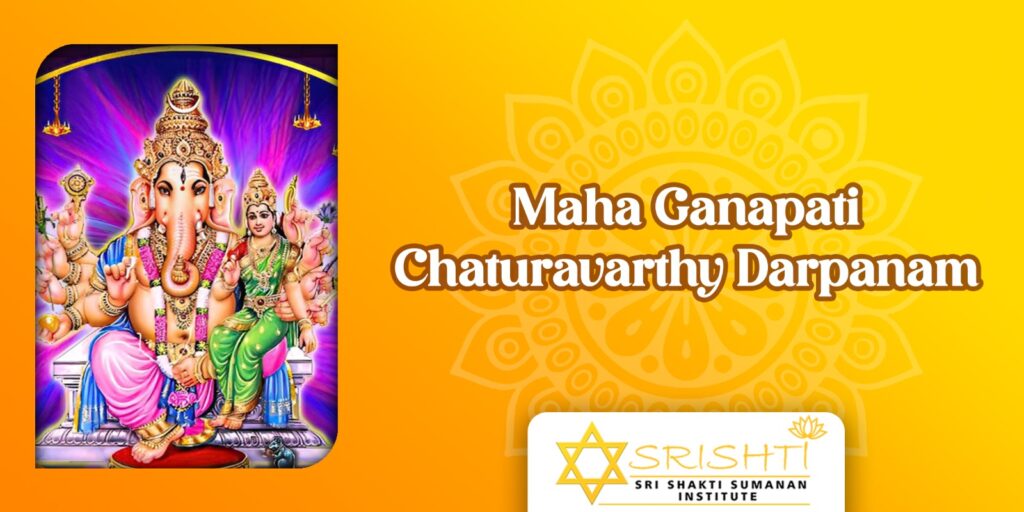
In the profound path of Śrī Vidyā Upāsanā, Mahā Gaṇapati holds an irreplaceable and exalted position. Known as the lord of auspicious beginnings (śubharambha), remover of obstacles (vighnahartā), and granter of supreme wisdom (buddhiprada), Mahā Gaṇapati is the deity whose blessings are sought before undertaking any spiritual practice. His Upāsanā is essential for aligning one’s spiritual journey with divine grace and ensuring success (siddhi) in the intricate and transformative practices of Śrī Vidyā.
The Significance of Mahā Gaṇapati in Śrī Vidyā
The Śrī Vidyā tradition is a deeply esoteric and spiritually demanding practice. It involves the worship of Tripurasundarī, the embodiment of the supreme consciousness and cosmic energy. However, the practitioner must first establish a connection with Mahā Gaṇapati to overcome obstacles (vighna) and prepare their inner and outer realms for the divine pursuit.
Mahā Gaṇapati is not merely a deity of beginnings but the Prathama Deva, the first among gods, and the Ādi Guru, the primordial teacher. His Upāsanā clears the aspirant’s spiritual path, removes karmic impediments, and ensures that their mind is imbued with clarity, focus, and receptivity to the higher energies of Śrī Vidyā.
Who is Mahā Gaṇapati?
The term “Mahā Gaṇapati” signifies the supreme aspect of Gaṇeśa, the son of Śiva and Pārvatī. While Gaṇeśa is often worshiped as a remover of obstacles, Mahā Gaṇapati is worshiped as the lord of wisdom, prosperity, and higher spiritual insight. In Śrī Vidyā, he is revered as the one who initiates the sādhaka into the mysteries of the Śrī Yantra and facilitates their journey towards ultimate realization.
His form is described in various Āgamas and Purāṇas as being radiant, adorned with red hues (raktavarṇa), holding a noose (pāśa), an elephant goad (aṅkuśa), and a sweet modaka in his hands. This iconography symbolizes control over desires, guidance towards the divine, and the bliss of spiritual fulfillment.
Mahā Gaṇapati Mantra and Its Power
The Mahā Gaṇapati mantra is a cornerstone of Śrī Vidyā practice.
This mantra encapsulates Mahā Gaṇapati’s blessings for wisdom, prosperity, success, and the removal of all obstacles in both material and spiritual realms.
The vibration of this mantra, when chanted with devotion and proper guidance, harmonizes the sādhaka’s energy with the cosmic forces. It prepares the mind for the higher vibrations of Śrī Vidyā and ensures that the sādhaka can fully absorb the teachings and practices without hindrance.
Importance of Mahā Gaṇapati Upāsanā
- Removal of Obstacles
Mahā Gaṇapati is renowned as Vighneśvara, the remover of all obstacles (vighna). In Śrī Vidyā, these obstacles could be physical, mental, or karmic. His Upāsanā clears these hurdles, paving the way for an unimpeded spiritual journey. - Purification of the Mind
His worship purifies the aspirant’s mind, making it a fit vessel to receive the subtle energies and wisdom of Śrī Vidyā. Without this purification, the deeper layers of Śrī Vidyā practice remain inaccessible. - Awakening of Intellect and Discrimination
Mahā Gaṇapati is the giver of buddhi (intelligence) and viveka (discrimination). These are essential for comprehending the intricate philosophy and practices of Śrī Vidyā. - Foundation for Spiritual Practices
No Upāsanā in Śrī Vidyā can commence without first invoking Mahā Gaṇapati. This is why he is called the Pūrvadevatā (the deity who must be worshiped first). - Granting Siddhi (Success)
In Śrī Vidyā, the ultimate goal is the union with the divine through the Śrīcakra. Mahā Gaṇapati ensures success (siddhi) in these practices by removing external and internal barriers.
Mahā Gaṇapati Upāsanā is a profound practice that encompasses various rituals to invoke the blessings of the remover of obstacles and the granter of supreme wisdom. These practices range from simple daily prayers to elaborate rituals, each contributing to the sādhaka’s spiritual evolution. Among the key rituals, the Chaturāvarthi Tarpanam and Sahasranāma Recitation hold a pivotal place in ensuring the success of spiritual endeavors, particularly in Śrī Vidyā.
- Sahasranāma Recitation (Thousand Names of Mahā Gaṇapati)
The recitation of the Mahā Gaṇapati Sahasranāma is a highly revered practice that invokes the deity’s thousand divine attributes. Each name represents a unique quality of Mahā Gaṇapati, and chanting them sequentially creates a powerful resonance that cleanses the practitioner’s consciousness and aligns their energies with the cosmic order. This recitation is a transformative practice that deepens the sādhaka’s connection with Mahā Gaṇapati, ensuring blessings for spiritual and material success. - Aṣṭottara Śatanāma Stotra (108 Names of Mahā Gaṇapati)
Chanting the 108 names of Mahā Gaṇapati is a simpler yet potent form of Upāsanā that invokes specific blessings and attributes of the deity. This practice enhances focus, devotion, and readiness for advanced rituals in Śrī Vidyā. - Yantra Pūjā
The Mahā Gaṇapati Yantra, a sacred geometric representation, acts as a focal point for divine energy. Worshiping this Yantra aligns the sādhaka’s inner and outer energies, providing strength and clarity essential for the deeper practices of Śrī Vidyā. - Mantra Japa
The repetition of the Mahā Gaṇapati mantra with devotion and precision amplifies the sādhaka’s spiritual vibration, purifying the mind and creating a strong foundation for the path of Śrī Vidyā. The power of Japa lies in its ability to harmonize the sādhaka’s subtle energies and establish a connection with the deity. - Chaturāvarthi Tarpanam
Among the most profound rituals, Chaturāvarthi Tarpanam involves offering oblations (tarpana) to Mahā Gaṇapati in the four directions, symbolizing the harmonization and purification of the sādhaka’s environment and self. This unique practice is highly effective in removing obstacles, attracting divine grace, and creating a protective spiritual shield around the practitioner. It is especially significant in Śrī Vidyā, ensuring that the sādhaka’s spiritual journey is unimpeded and fruitful.
Benefits of Mahā Gaṇapati Upāsanā
- Material Prosperity: Ensures success in worldly endeavors and financial stability.
- Spiritual Growth: Facilitates deep meditative states and the awakening of inner potential.
- Mental Clarity: Brings focus, intellect, and creativity, necessary for spiritual progress.
- Overcoming Challenges: Provides strength to overcome life’s difficulties and karmic barriers.
- Divine Protection: Envelops the aspirant in the grace of Mahā Gaṇapati, shielding them from negativity.
Conclusion
The path of Śrī Vidyā is one of profound transformation and divine realization. However, this journey is fraught with challenges that require the aspirant to invoke the grace and guidance of Mahā Gaṇapati. By performing his Upāsanā with sincerity and devotion, one not only secures success in Śrī Vidyā but also unlocks the deeper dimensions of life, leading to ultimate liberation (mokṣa).
Mahā Gaṇapati is not just the beginning of the path; he is the foundation upon which the edifice of Śrī Vidyā is built. His blessings ensure that the aspirant’s journey is auspicious, enlightened, and aligned with the supreme truth. Oṁ Gaṁ Gaṇapataye Namaḥ!
Navagraha Gāyatrī Sādhanā: A Path to Harmonize Graha Energies
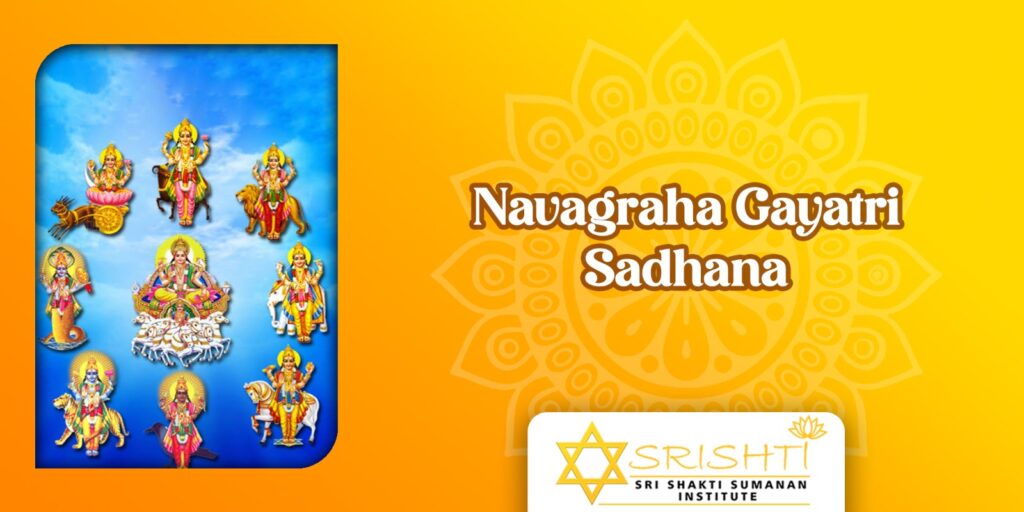
In Vedic tradition, the Navagrahas (nine celestial influencers) hold a significant role in shaping human destiny. These Grahas, as understood through Jyotiṣa (Vedic astrology), govern various aspects of life, including physical, mental, emotional, and spiritual well-being. Each Graha represents specific energies and attributes, influencing the individual’s karmic journey. Navagraha Gāyatrī Sādhanā is a spiritual practice designed to invoke the blessings of these Grahas through their unique Gāyatrī mantras. This practice harmonizes their energies, mitigates malefic influences, and enhances auspicious aspects of life.
Navagrahas and Their Connection to Gāyatrī Upāsanā
The Navagrahas are considered the eighth āvaraṇa (enclosure) of Gāyatrī Devī in her cosmic form. In Gāyatrī Upāsanā, each āvaraṇa represents a stage of spiritual evolution and corresponds to specific deities, energies, and principles. The eighth āvaraṇa signifies the influence of the nine Grahas on the sādhaka’s journey.
Gāyatrī Devī, as the ultimate cosmic power, governs all aspects of existence, including the Grahas. The Navagrahas act as her emissaries, guiding and shaping the karmic patterns of individuals. Thus, invoking the Navagrahas is not merely planetary worship but an integral part of advancing in Gāyatrī Upāsanā, aligning the microcosm of the individual with the macrocosm of the universe.
Performing Navagraha Gāyatrī Sādhanā harmonizes the Graha energies, allowing the sādhaka to progress through the eighth āvaraṇa and prepare for deeper communion with Gāyatrī Devī.
The Nine Grahas and Their Roles in Life
- Sūrya (Sun)
- Role: Represents the soul (ātman), vitality, leadership, and self-confidence. Governs health, career, and fatherly relationships.
- Mantra: You will receive from your Guru.
- Benefit: Enhances inner strength, self-esteem, and clarity of purpose. Mitigates ego and restores balance in leadership roles.
- Candra (Moon)
- Role: Governs the mind (manas), emotions, intuition, and maternal relationships. Influences mental stability, emotional well-being, and creativity.
- Mantra: You will receive from your Guru.
- Benefit: Cultivates emotional resilience, enhances intuition, and balances mental health.
- Maṅgala (Mars)
- Role: Symbolizes strength, courage, determination, and discipline. Governs physical energy, ambition, and sibling relationships.
- Mantra: You will receive from your Guru.
- Benefit: Enhances physical vitality, courage, and willpower. Mitigates aggression and impulsive tendencies.
- Budha (Mercury)
- Role: Represents intellect, communication, analytical thinking, and business acumen. Governs education and relationships with friends.
- Mantra: You will receive from your Guru.
- Benefit: Sharpens intellect, improves communication skills, and promotes success in academics and commerce.
- Bṛhaspati (Jupiter)
- Role: Governs wisdom, spirituality, dharma, and wealth. Represents teachers, mentors, and divine grace.
- Mantra: You will receive from your Guru.
- Benefit: Attracts divine guidance, expands wisdom, and fosters prosperity and spiritual growth.
- Śukra (Venus)
- Role: Symbolizes beauty, love, creativity, and material comforts. Governs relationships, luxury, and artistic pursuits.
- Mantra: You will receive from your Guru.
- Benefit: Enhances creativity, harmonizes relationships, and promotes material prosperity and artistic expression.
- Śani (Saturn)
- Role: Represents discipline, karma, endurance, and spiritual detachment. Governs career, service, and long-term goals.
- Mantra: You will receive from your Guru.
- Benefit: Cultivates patience, perseverance, and acceptance. Reduces the malefic effects of karmic debts.
- Rāhu (North Lunar Node)
- Role: Governs material desires, ambition, and unconventional thinking. Influences innovation, challenges societal norms, and fosters worldly achievements.
- Mantra: You will receive from your Guru.
- Benefit: Aligns desires with higher goals, mitigates confusion, and brings success in worldly pursuits.
- Ketu (South Lunar Node)
- Role: Represents spiritual detachment, liberation, and intuition. Governs past karmas, transcendental knowledge, and mokṣa.
- Mantra: You will receive from your Guru.
- Benefit: Enhances spiritual growth, reduces material attachment, and clears past karmic influences.
Benefits of Navagraha Gāyatrī Sādhanā
- Harmonizing Graha Energies
Regular practice ensures that the energies of the Navagrahas are balanced, reducing their malefic effects and amplifying positive influences. - Progress in Gāyatrī Upāsanā
As the Navagrahas form the eighth āvaraṇa of Gāyatrī Devī, their harmonization is essential for advancing through this stage of Upāsanā. It prepares the sādhaka for deeper spiritual experiences and union with Gāyatrī Devī. - Mitigating Challenges in Jyotiṣa
Navagraha Gāyatrī Sādhanā serves as a powerful remedy for challenges posed by unfavorable Graha alignments (doṣas), offering relief from difficulties. - Enhancing Material and Spiritual Growth
Aligning with the Grahas’ energies ensures both material prosperity and spiritual elevation, leading to a balanced and fulfilling life. - Removing Obstacles
Each Graha governs specific obstacles. Performing this sādhanā ensures these barriers are removed, creating a smooth path for success. - Improving Mental and Emotional Balance
The focused invocation of the Navagrahas enhances mental clarity, emotional stability, and intuitive insight, fostering inner peace. - Attracting Divine Grace
Aligning oneself with the Navagrahas invites divine protection and guidance, supporting both mundane and spiritual endeavors.
Navagraha Gāyatrī Sādhanā is more than a Graha-centered remedy—it is a spiritual gateway into the eighth āvaraṇa of Gāyatrī Upāsanā. By harmonizing Graha energies, the sādhaka deepens their relationship with Gāyatrī Devī, paving the way for higher stages of spiritual realization. Rooted in the principles of Jyotiṣa and Vedic wisdom, this sādhanā offers a holistic approach to life’s challenges and achievements, aligning the individual with the cosmic rhythm and ensuring peace, prosperity, and liberation.
Aṣṭa Mātṛkā: The Eight Divine Powers of Emotional Mastery
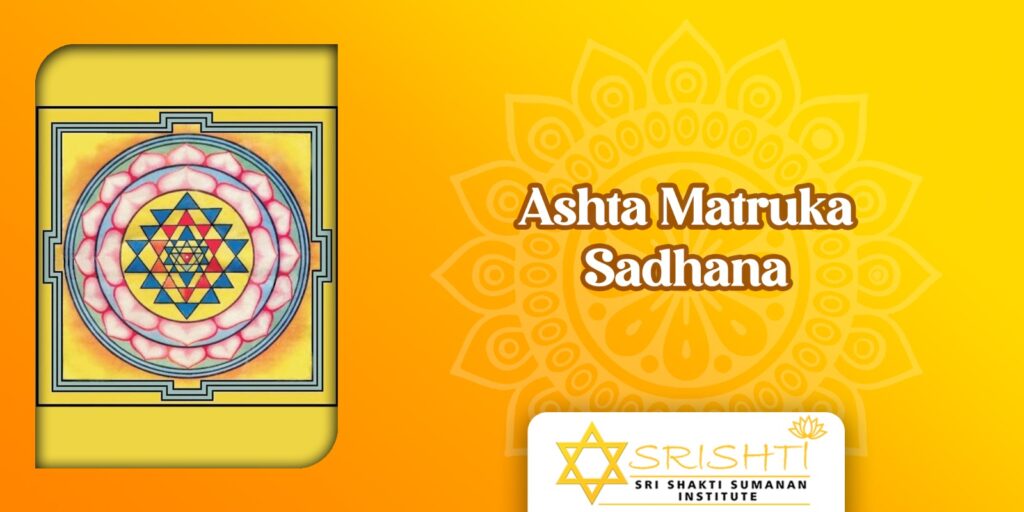
The Aṣṭa Mātṛkās (Eight Mothers) are a group of powerful deities revered in the Vedic and Tantric traditions as key intermediaries who aid spiritual seekers by bestowing the grace of Para Śakti, the Supreme Goddess. These divine feminine energies are intricately associated with different directions and intermediate directions, symbolizing their omnipresence and cosmic role in guiding humanity. They include Brahmī, Māheśvarī, Kaumārī, Vaiṣṇavī, Vārāhī, Māhendrī, Cāmuṇḍā, and Mahālakṣmī. Each Mātṛkā represents a specific aspect of the supreme divine consciousness and provides practical and spiritual benefits, addressing various facets of human life, emotions, and existence.
The Aṣṭa Mātṛkās are also symbolically placed within the square enclosure of the Śrī Yantra, representing their pivotal role in connecting human aspirations with the cosmic consciousness.
The Eight Mātṛkās and Their Divine Roles
- Brahmī (East)
- Role: The Śakti of Brahmā, representing creativity, knowledge, and the arts. She embodies Sarasvatī, the goddess of wisdom and learning.
- Significance: Brahmī inspires creative endeavors and intellectual pursuits, making her worship essential for education, learning, and artistic expression.
- Benefit: Enhances creativity, wisdom, and clarity of thought, improving the quality of life through knowledge and innovation.
- Māheśvarī (South)
- Role: The Śakti of Śiva, embodying Mahat Tattva (the principle of greatness). She signifies righteous action and the controlled application of power.
- Significance: Māheśvarī aids in achieving greatness, particularly in business and leadership, ensuring ethical decisions and timely action.
- Benefit: Brings focus, ethical strength, and the competitive edge necessary for success, while fostering perseverance and integrity.
- Kaumārī (West)
- Role: The Śakti of Kumāra (Skanda), representing the serpent power of Kuṇḍalinī Śakti and balance of the chakras. She is associated with vitality and procreation.
- Significance: Kaumārī’s worship is essential for balancing energies within the body and creating conditions conducive to progeny and vitality.
- Benefit: Promotes physical well-being, balances the chakras, and aids couples seeking progeny by fostering hormonal wellness and fertility.
- Vaiṣṇavī (North)
- Role: The Śakti of Viṣṇu, symbolizing Māyā and harmonious relationships. She represents the sustaining power of the universe.
- Significance: Vaiṣṇavī creates and nurtures harmonious relationships in various aspects of life, including marriage, friendship, and familial ties.
- Benefit: Enhances the quality of relationships, fosters harmony, and strengthens emotional bonds, reducing discord and fostering unity.
- Vārāhī (South-East)
- Role: The commander of Lalitā Devī’s armed forces, symbolizing control over inner enemies like kāma (desire), krodha (anger), and lobha (greed).
- Significance: Vārāhī resides at the Ājñā Chakra, enabling the practitioner to command internal and external energies to overcome obstacles.
- Benefit: Helps treat diseases, subdue emotional imbalances, and support terminally ill patients. She aids in the conquest of negative tendencies and fosters holistic well-being.
- Māhendrī (South-West)
- Role: The Śakti of Indra, the rain god, symbolizing fertility, nourishment, and environmental harmony.
- Significance: Māhendrī governs agricultural prosperity, rain, and protection from natural calamities. She also supports environmental balance.
- Benefit: Ensures prosperity in agriculture, improves dairy production, and aids in environmental protection. Her worship benefits those in the agro-industry.
- Cāmuṇḍā (North-West)
- Role: A fierce aspect of Durgā, she eliminates negativity and protects against evil forces. She is the embodiment of Chandi energy.
- Significance: Cāmuṇḍā controls and annihilates evil forces and protects practitioners from malefic influences.
- Benefit: Offers protection, eliminates curses, and ensures victory over external and internal enemies, fostering spiritual and physical safety.
- Mahālakṣmī (North-East)
- Role: The Śakti of wealth, abundance, and cosmic awareness. She embodies the infinite prosperity of the universe.
- Significance: Mahālakṣmī governs material and spiritual wealth, fostering a sense of divine abundance and detachment from petty concerns.
- Benefit: Bestows material wealth, spiritual wisdom, and a state of inner contentment. Her grace leads to the realization of infinite consciousness.
The Spatial Arrangement of Aṣṭa Mātṛkās
The Aṣṭa Mātṛkās are associated with specific directions and occupy a vital position in the Śrī Yantra:
- Brahmī: East
- Māheśvarī: South
- Kaumārī: West
- Vaiṣṇavī: North
- Vārāhī: South-East
- Māhendrī: South-West
- Cāmuṇḍā: North-West
- Mahālakṣmī: North-East
This spatial arrangement represents their cosmic omnipresence and their ability to influence every aspect of life and existence.
The Aṣṭa Mātṛkās are powerful deities who embody the essence of emotional mastery and cosmic balance. Their energies align with specific directions and spiritual principles, making them indispensable guides in the quest for self-realization and well-being. By propitiating these divine mothers, practitioners can attain mastery over their emotions, foster harmonious relationships, and achieve spiritual and material prosperity. The Aṣṭa Mātṛkās are not only guardians of the individual soul but also conduits of Para Śakti’s boundless grace, guiding humanity toward enlightenment and eternal harmony.
Mahāmṛtyuñjaya-Sādhana
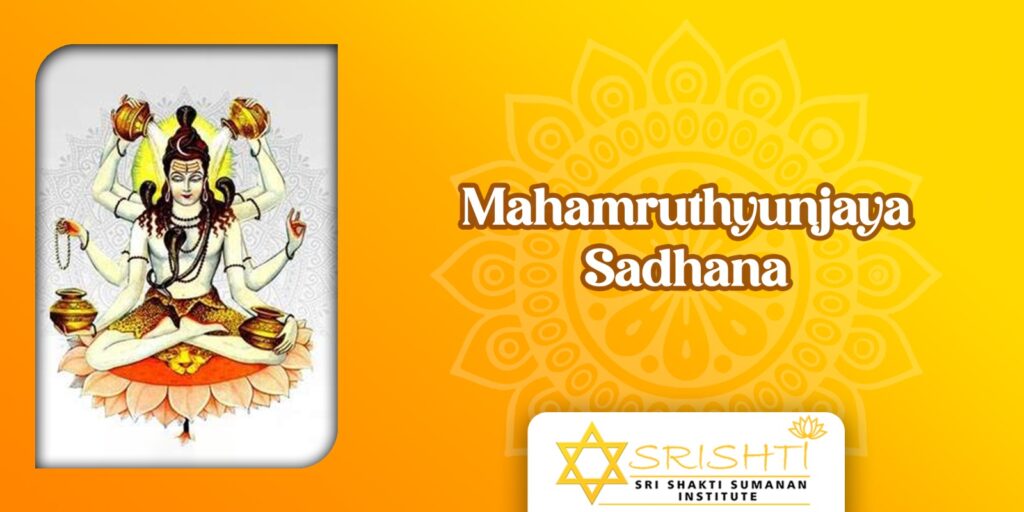
Mahāmṛtyuñjaya-Sādhana
Mahālakṣmī Upāsanā: Embracing the Divine Grace of Harmony and Abundance
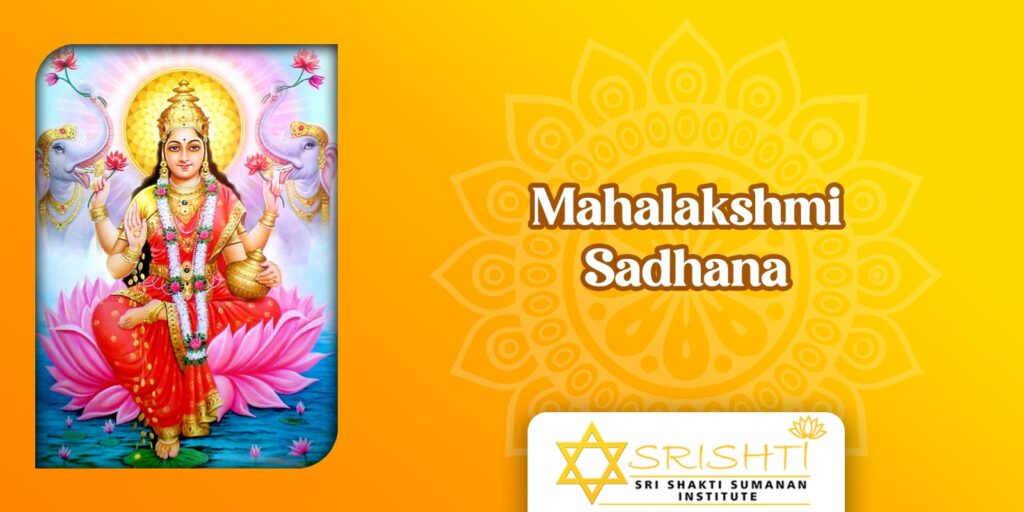
Mahālakṣmī, the goddess of beauty (saundarya), harmony, and divine abundance, embodies radiant energy, grace, and the power to attract and unify. She is not merely a representation of material wealth but also of deeper, subtler divine qualities that elevate human life to its fullest potential. Her mohana śakti (enchanting power) is unique, as it draws beings toward her with magnetic charm while infusing their lives with harmony, beauty, and fulfillment.
The Nature of Mahālakṣmī
Mahālakṣmī is more than an expression of jñāna (wisdom) and śakti (power); she is the very essence of beauty, rhythm, and harmony that binds all aspects of existence. Without her presence, even knowledge and power remain incomplete. Her divine nature transcends ordinary understanding, radiating a mesmerizing energy that unifies and uplifts the universe. Her mohana śakti is not just enchanting but transformative, influencing everything from the smallest particles to the vast cosmic play, orchestrating them into rhythm and harmony.
The Role of Mahālakṣmī in Human Life
- Attraction to Divinity
For embodied souls, there is no divine power more captivating than Mahālakṣmī. She emanates divine sweetness (mādhurya) and intoxication that draws the soul into divine ecstasy. To feel her presence is to experience life as a wondrous, blissful journey. - Inner Transformation
Mahālakṣmī brings grace and refinement to the heart, mind, and body. Her touch purifies the mind, fills the heart with divine love, and elevates the soul to states of transcendent joy. Her radiance beautifies all that she touches, turning the mundane into the miraculous. - Harmony in Thoughts and Actions
Mahālakṣmī teaches us the importance of cultivating harmony in all aspects of life: in the mind, emotions, external actions, and even in the environment. Her power invites unity and coherence in every movement of life. - Divine Artistry
With her influence, life transforms into a divine art form. The simplest aspects of existence align with higher cosmic order, and ordinary objects become extraordinary expressions of divine creativity.
Conditions for Invoking Mahālakṣmī’s Grace
Mahālakṣmī does not dwell where there is disharmony, impurity, or a lack of beauty and love. To invoke her divine presence, certain qualities must be cultivated:
- Inner Purity and Harmony
Mahālakṣmī thrives in hearts free from kāmā (selfish desires), krodha (anger), lobha (greed), mātsarya (jealousy), and other negative tendencies. She withdraws from places tainted by disharmony, selfishness, or crudeness. - Cultivation of Love and Beauty
Love and beauty are her natural domains. Where there is an aspiration for refinement, divine love, and harmonious living, she readily bestows her blessings. - Receptivity and Devotion
True devotion to Mahālakṣmī involves aligning the heart, thoughts, and actions with her principles of harmony, unity, and divine rhythm.
The Blessings of Mahālakṣmī Upāsanā
- Material and Spiritual Abundance
Mahālakṣmī not only bestows wealth and prosperity but also imparts spiritual riches, elevating the soul to divine consciousness. - Harmony and Beauty in Life
Her grace fills life with peace, balance, and beauty, creating an environment conducive to joy and spiritual growth. - Unity and Integration
Mahālakṣmī unifies all elements of life into a cohesive whole, guiding individuals toward a harmonious relationship with the divine. - Transcendent Joy
She leads the devotee beyond the limitations of the intellect into realms of ānanda (bliss), where life becomes a profound celebration of divine love and grace.
Mahālakṣmī’s Role in Spiritual Practice
In spiritual practice, Mahālakṣmī connects bhakti (devotion) with divine attraction, intensifying the seeker’s relationship with the divine. She harmonizes strength and grace, teaches the rhythm of divine action, and infuses the practice with mohana śakti, ensuring that spiritual accomplishments are sustained and enriched by divine love. Mahālakṣmī is the ultimate embodiment of divine harmony, beauty, and abundance. To invoke her grace is to invite transformation at every level—physical, emotional, mental, and spiritual. Through Mahālakṣmī Upāsanā, life becomes a divine art, where every experience reflects her infinite wisdom and beauty. She draws the seeker toward the highest states of ānanda, turning even the simplest moments into profound expressions of divine bliss. In her presence, life transcends its limitations, becoming a reflection of the divine perfection she embodies.
Śrī-Durgā-Sādhana
Śrī-Sarasvatī-Sādhana
Śrī-Rādhā-Sādhana
Pañcamī-Vārāhī-Upāsanā

Panchami Varahi Upasana is a sacred practice dedicated to Varahi, the commander of the Universal Primordial Energy. Varahi is known for her unique ability to purify the inner senses of the Sadhaka, drawing them closer to the divine mother. Residing in the brow center as the ruler of the Ajna Chakra, Varahi reveals the divine consciousness to the practitioner, guiding them towards a harmonious and powerful life.
Agastya-Kula-Śrī-Svarṇākarṣaṇa-Bhairava-Sādhana

Agastya-Kula-Śrī-Svarṇākarṣaṇa-Bhairava-Sādhana
Śrī-Amṛta-Bhairava-Sādhana

Śrī-Amṛta-Bhairava-Sādhana
